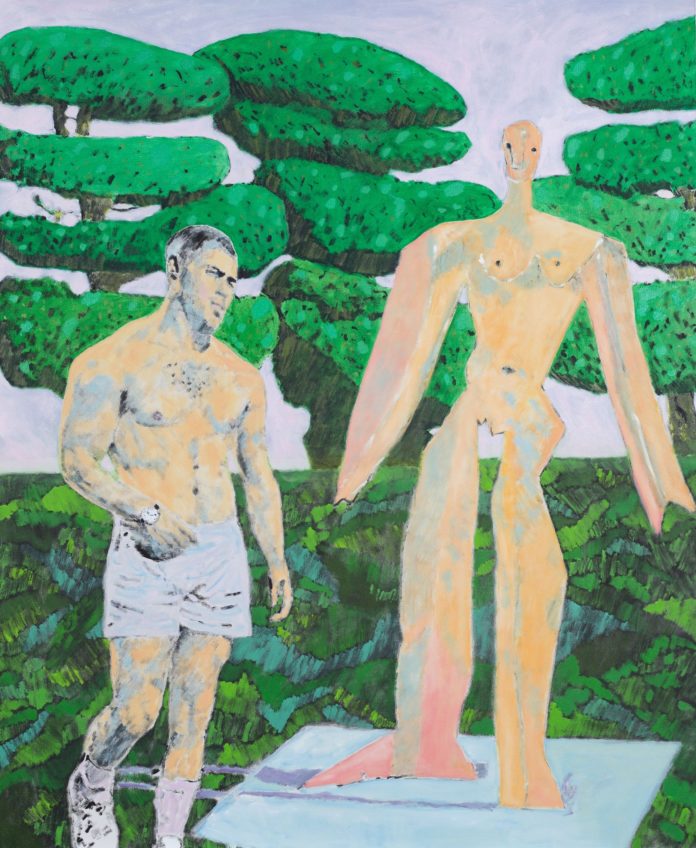Sandro Botticelli’s “Portrait of a Young Man,” owned by the National Gallery in London, is a quietly revolutionary painting. It shows a beautiful youth, with brown hair falling in waves from his red cap to a brown doublet tied at the neck. He turns his whole face toward the viewer, a pose reserved until this point, in Italian Renaissance painting, for devotional images of Christ. His cheeks are red, his full lips set in a slightly asymmetrical expression, at once eloquent and enigmatic. His eyes, large and brown, suffused with light falling from the left, gaze directly at us.
Standing before this painting in 2006, newly relocated to London for his partner’s career, a twenty-seven-year-old from Kentucky named John Brooks had a curious experience of time. He had long been interested in art, having drawn avidly as a child and taken painting classes in high school and college. But, in Frankfort, the small state capital where he grew up, his access to art was limited; certainly, he didn’t know of any professional artists. Life as a painter “wasn’t even remotely possible,” he told me recently. When he first stood in front of the Botticelli, which he visited often during the next four years, he was transfixed by the presence that he felt in the painting; he had a revelation of art as a way to travel through time. “I could feel what he was feeling, and what he was feeling was something I had felt before,” Brooks said. “I think it was myself that I recognized in what I was feeling.” The experience clarified a sense of vocation: from this moment, he would dedicate himself to painting.
“Queer time” is a popular notion among a certain cohort of aestheticians and philosophers. Used loosely, the term can seem to suggest that any deviation from linearity is somehow queer—a dubious claim, given that philosophers have always distinguished between clock time and the vagaries of subjective temporality. But, for queer people, the historical unavailability of the conventional mile markers of maturation—marriage, parenthood, grandparenthood—has often led to more improvisatory and experimental shapes for a life. And the unique isolation of queer childhood—given that the vast majority of queer children are born into non-queer families, and that, until recently, those families were almost certain to be hostile to queerness—means that queer people often seek out companions in the noncontemporary: in literature, art, history. An unbearable present can send queer people on a journey through time, seeking resources in the past to imagine a more livable future. This double movement, looking backward and ahead at once, seems to me a hallmark of queer style.
To walk into Moremen Gallery, in Louisville, and view the exhibition of John Brooks’s new paintings is to have a visceral experience of queer time. The twenty-one oil paintings, most of them large format—roughly four and a half by four feet, or larger—use contemporary pop-culture references, allusions to art history and literature, and images of Brooks’s friends and social-media acquaintances to create a kind of trans-historical community.
At the entrance to the exhibition, which I visited several times in July and August, two large canvases feature the singer and actor Nick Jonas, an avatar, for Brooks, of a contemporary masculinity that he characterizes as “open” and “flexible.” In the first, Jonas stands in a large, V-neck purple sweater and shorts, against a background borrowed from the German artist Karl Schmidt-Rottluff. Behind Jonas, on the left, two collared golden poodles, one expressionless and the other yawning or yapping, stand unimpressed. The painting is called “We All Come and Go Unknown,” a line from Joni Mitchell’s “Hejira” that also serves as the title of the exhibition. Like most of the canvases in the show, the painting is made up almost entirely of found images, but Brooks uses found material the way that novelists use autobiography: everything is processed or transformed. Often, for Brooks, this involves doubling and radical, non-naturalistic color: here, Rottluff’s black-and-white woodcut “Russian Forest” is reimagined in green and a pastel shade of violet. As in many of the paintings, the human face is richly contradictory, sensuous in the lush pink of the lips but also obscured, as if partly smudged or scratched out. The figures are still, but there’s a sense of vibration in the contrary motion of the brushwork, from the purple, white, and black lines of Jonas’s sweater to the short, feathery strokes that make up the grass in the painting’s lower third.
Painting “We All Come and Go Unknown,” which would point the way for many of the other paintings, Brooks felt the excitement of unprecedented associations. “I was integrating things in a different way than I had before, things that were really disparate,” he told me. “And they felt new, because I felt, like, a guarantee that Nick Jonas and Karl Schmidt-Rottluff had never been put together.”
In the second Jonas painting, “Help Me to Name It,” the singer, now dressed only in athletic shorts, tennis shoes, and socks, with a watch prominent on one wrist, stands to the left of Picasso’s “Standing Nude,” a sculpture from 1960 or 1961. Jonas’s face is more available here, his expression theatrical, sultry or pained. The color of his skin matches the surface of Picasso’s sculpture. In a set of notes that Brooks wrote for the gallery, identifying his various sources, he explains that he began to see this painting as a play on Mary Shelley’s “Frankenstein,” thinking of the monster who longs, in the novel’s phrase, for a female companion “with whom I can live in the interchange of those sympathies necessary for my being.” Brooks’s juxtapositions establish resonances, not meanings. It’s tempting to discern, in the painting, a commentary on beauty, celebrity, commodification. But agitating against any programmatic argument is the work’s sexiness, and its humor. The first time I saw it, and looked from Jonas’s self-conscious expression to the sculpture’s affectless face, I laughed out loud.
At forty-three, Brooks is tall and thin, with shoulder-length brown hair. He tends to dress casually, at least in the Louisville summer—a T-shirt and shorts or jeans—and he speaks softly, his comments on the influences and intentions of his paintings frequently interrupted by self-deprecation. For all his travels, he retains a discernible Kentucky accent. He characterizes his family life as loving and stable, but remembers his childhood as a “desperately lonely” time. His father was the director of Parks and Recreation in Frankfort for thirty-eight years, and he encouraged his son to participate in team sports. Brooks hated them all—not least because of the relentless bullying inflicted on him by teammates on account of his effeminacy and sensitivity. He felt more comfortable with tennis and, especially, golf, his aptitude for which made him something of a local celebrity in his adolescence, and provided a degree of protection against the abuse of his peers. But he felt alienated by the sport’s conservative, heterosexual milieu, and stopped playing for two years in college. After some desultory work at golf clubs, and a few years playing amateur tournaments, he gave up the sport for good once he moved to London.
Brooks traces his fascination with Europe to the sense of isolation he felt as a queer kid—“I always had an eye on the horizon,” he told me—and also to his grandfather’s stories of fighting in the Second World War. He was captivated by his grandfather’s life, which arced from small-town Shelbyville, Kentucky, to intersect with the “harrowing but grand” sweep of world history. Brooks’s partner, whom he met in 2002, had lived in Germany, and he introduced Brooks to German expressionism, the influence of which is evident in both the style and the content of the current paintings. Brooks became fascinated by Berlin as a city swept up by all the currents of the twentieth century, by the horrors of fascism but also artistic and sexual liberation.
In his new paintings, Brooks draws especially on artists who, like Rottluff, were branded by the Nazis as degenerate for their sexual or aesthetic deviance. In Brooks’s “Degenerates,” Marlene Dietrich and the painter Max Beckmann flank Gabriel Pessoto, a young queer Brazilian artist whom Brooks knows via Instagram; the background is a much altered image from another “degenerate” artist, Vasily Kandinsky. Dietrich, in tuxedo and top hat, also appears in “Mind Over Matter Is Magic,” this time alongside an acquaintance and fellow-Louisvillian, Kris White, and an image by August Sander; they stand against a background taken (also greatly altered) from Ernst Ludwig Kirchner. With a title from a Frank Ocean lyric, the painting brings together artists from across the twentieth and twenty-first centuries; the principle drawing them together seems less argument-driven than libidinal.
Nearly all of Brooks’s paintings, though they mostly lack the usual signifiers of emotion, pulse with desire. This is especially true of “Cloudbusting,” which features Brooks’s most moving quotation: two laughing men, on either side of the painting, drawn from a photograph by Herbert List, a queer artist of Jewish descent who fled the Nazis and made lyrical, homoerotic photographs of young men in Mediterranean landscapes. Between the pair, another queer artist whom Brooks knows from Instagram, Carlos Garza, sits in athletic shorts, his hoodie drawn up over his stomach, scrolling on his phone in a posture at once insouciant, aggressive, and exhibitionist. In this painting, as in several others, the collage composition suggests but doesn’t provide a narrative. It’s easy to imagine a locker-room scene, List’s innocently laughing men transformed into something mocking or predatory, almost leering. The painting is disturbing, slightly sinister, and extremely sexy, generating drama through its mise en scène but also through color: the three men are painted in shades of yellow that sharply contrast with the shock of luxurious blue at the painting’s base. The red lettering on a cloud of plastic tape at the painting’s top is echoed by a single stripe along the bottom of the central figure’s shoes.
Brooks’s historical borrowings are all haunted by the present. His invocations of the aesthetic and erotic freedom of the twenties in Berlin are shadowed by our knowledge of the decades that followed, and by our awareness of the fragility of progress. The exhibit’s most disturbing painting, “The Threat,” features a background borrowed from the American filmmaker Bob Mizer, whose homoerotic photographs of athletes and soldiers helped define the gay male erotic imaginary in the nineteen-fifties and sixties. Four armed and shirtless men, fascistic in their helmets and boots, square off with pistols and rifles. Brooks connects the barrels of the rifles, at once heightening the eroticism of the image and suggesting the self-destructive quality of white male violence. In the foreground, the Black American model Alton Mason, dressed in what seems to be a skirt, with jewelry at his neck and wrists (the image is taken from Mason’s Instagram), poses regal and confident, entirely unconcerned with the pageantry of aggression at his back. Brooks conceived of the painting after listening to an interview with the historian Carol Anderson, whose book “The Second” details the racist origins of the Second Amendment. “Simply being Black has been perceived as a threat,” Brooks recalls Anderson saying. Just blocks from the gallery, boarded-up storefronts are a reminder of the protests that erupted in response to the murders of George Floyd and Breonna Taylor. The threat of the painting’s title is not posed by the figure at its center; although the picture is unsettling, there is something hopeful, even utopian, about his nonchalance.







